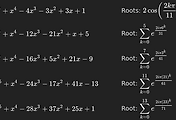미적분학(calculus)에서, 몫 규칙(quotient rule)은 두 미분-가능한 함수의 비율인 함수(function)의 도함수(derivative)를 찾는 방법입니다. \(\displaystyle f(x)=g(x)/h(x)\)로 놓는데, 여기서 \(\displaystyle g\)와 \(\displaystyle h\) 둘 다는 미분-가능이고, \(\displaystyle h(x)\neq 0\)입니다. 몫 규칙은 \(\displaystyle f(x)\)의 도함수가 다음임을 말합니다:
\(\quad\displaystyle f'(x) = \frac{g'(x)h(x) - g(x)h'(x)}{[h(x)]^2}.\)
Examples
1. 기본 예제:
\(\quad\displaystyle \begin{align}
\frac{d}{dx} \frac{e^x}{x^2} &= \frac{\left(\frac{d}{dx}e^x\right)(x^2) - (e^x)\left(\frac{d}{dx} x^2\right)}{(x^2)^2} \\
&= \frac{(e^x)(x^2) - (e^x)(2x)}{x^4} \\
&= \frac{e^x(x - 2)}{x^3}.
\end{align}\)
2. 몫 규칙은 다음처럼 \(\displaystyle f(x) = \tan x = \tfrac{\sin x}{\cos x}\)의 도함수를 찾기 위해 사용될 수 있습니다.
\(\quad\displaystyle \begin{align}
\frac{d}{dx} \tan x &= \frac{d}{dx} \frac{\sin x}{\cos x} \\
&= \frac{\left(\frac{d}{dx}\sin x\right)(\cos x) - (\sin x)\left(\frac{d}{dx}\cos x\right)}{\cos^2 x} \\
&= \frac{\cos^2 x + \sin^2 x}{\cos^2 x} \\
&= \frac{1}{\cos^2 x} = \sec^2 x.
\end{align}\)
Proofs
Proof from derivative definition and limit properties
\(\displaystyle f(x) = g(x)/h(x)\)로 놓습니다. 도함수의 정의와 극한의 속성을 적용하여 다음 증명을 제공합니다.
\(\quad\displaystyle \begin{align}
f'(x) &= \lim_{k\to 0} \frac{f(x+k) - f(x)}{k} \\
&= \lim_{k\to 0} \frac{\frac{g(x+k)}{h(x+k)} - \frac{g(x)}{h(x)}}{k} \\
&= \lim_{k\to 0} \frac{g(x+k)h(x) - g(x)h(x+k)}{k \cdot h(x)h(x+k)} \\
&= \lim_{k\to 0} \frac{g(x+k)h(x) - g(x)h(x+k)}{k} \cdot \lim_{k\to 0}\frac{1}{h(x)h(x+k)} \\
&= \left(\lim_{k\to 0} \frac{g(x+k)h(x) - g(x)h(x) + g(x)h(x) - g(x)h(x+k)}{k} \right) \cdot \frac{1}{h(x)^2} \\
&= \left(\lim_{k\to 0} \frac{g(x+k)h(x) - g(x)h(x)}{k} - \lim_{k\to 0}\frac{g(x)h(x+k) - g(x)h(x)}{k} \right) \cdot \frac{1}{h(x)^2} \\
&= \left(h(x)\lim_{k\to 0} \frac{g(x+k) - g(x)}{k} - g(x)\lim_{k\to 0}\frac{h(x+k) - h(x)}{k} \right) \cdot \frac{1}{h(x)^2} \\
&= \frac{g'(x)h(x) - g(x)h'(x)}{h(x)^2}.
\end{align}\)
Proof using implicit differentiation
\(\displaystyle f(x) = \frac{g(x)}{h(x)}\)로 놓는데, 그래서 \(\displaystyle g(x) = f(x)h(x)\)입니다. 곱 규칙(product rule)은 그런-다음 \(\displaystyle g'(x)=f'(x)h(x) + f(x)h'(x)\)를 제공합니다. \(\displaystyle f'(x)\)에 대해 풀고 \(\displaystyle f(x)\)에 대해 다시 대체하면 다음을 제공합니다:
\(\quad\displaystyle \begin{align}
f'(x) &= \frac{g'(x) - f(x)h'(x)}{h(x)} \\
&= \frac{g'(x) - \frac{g(x)}{h(x)}\cdot h'(x)}{h(x)} \\
&= \frac{g'(x)h(x) - g(x)h'(x)}{h(x)^2}.
\end{align}\)
Proof using the chain rule
\(\displaystyle f(x) = \frac{g(x)}{h(x)} = g(x)h(x)^{-1}\)로 놓습니다. 그런-다음 곱 규칙은 다음을 제공합니다:
\(\quad\displaystyle f'(x) = g'(x)h(x)^{-1} + g(x) \cdot \frac{d}{dx}(h(x)^{-1}). \)
두 번째 항에서 도함수를 평가하기 위해, 체인 규칙(chain rule)과 함께 거듭제곱 규칙(power rule)을 적용하십시오:
\(\quad\displaystyle f'(x) = g'(x)h(x)^{-1} + g(x) \cdot (-1) h(x)^{-2} h'(x).\)
마지막으로, 분수로 다시-쓰고 항들을 결합한 후 다음을 얻습니다:
\(\quad\displaystyle \begin{align}
f'(x) &= \frac{g'(x)}{h(x)} - \frac{g(x)h'(x)}{h(x)^2} \\
&= \frac{g'(x)h(x) - g(x)h'(x)}{h(x)^2}.
\end{align}\)
Higher order formulas
암시적 미분화는 몫의 (부분적으로 그것의 첫 번째 n − 1 도함수의 v 도함수를 계산하기 위해 사용될 수 있습니다. 예를 들어, \(\displaystyle fh=g\)을 두-번 미분한 다음 (\(\displaystyle f''h + 2f'h' + fh'' = g''\)의 결과에서) \(\displaystyle f''\)에 대해 풀면 다음을 산출합니다:
\(\quad\displaystyle f'' = \left(\frac{g}{h}\right)'' = \frac{g'' - 2f'h' - fh''}{h}.\)
References
- Stewart, James (2008). Calculus: Early Transcendentals (6th ed.). Brooks/Cole. ISBN 0-495-01166-5.
- Larson, Ron; Edwards, Bruce H. (2009). Calculus (9th ed.). Brooks/Cole. ISBN 0-547-16702-4.
- Thomas, George B.; Weir, Maurice D.; Hass, Joel (2010). Thomas' Calculus: Early Transcendentals (12th ed.). Addison-Wesley. ISBN 0-321-58876-2.

